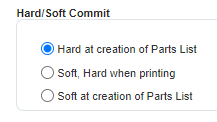dosinger
Member
We have two types of floor stock and am looking for different treatment in JDE.
We have vendor managed inventory that gets delivered directly to the production floor. We code this with Stk Typ I (Vendor Managed Inventory) and uses Issue Type F (Floor Stock) in BOMs.
We also have regular inventory that is procured by the buyers, comes to the receiving dock and gets put on the shelf. When needed on the floor, it is issued using an II transaction (Inventory Issuance) after which it is treated like vendor managed. These parts have Stk Typ B. The trouble is the Issue Type Code.
If we use I (Manual Issue) then people on the production floor look at the parts list on the work order and try to get the part out of inventory (and not from the floor).
If we use F (Floor Stock), then the 07 Standard is zeroed out and the cost is not included in the roll-up of the assembly.
What we think we need is a hybrid Issue Type Code that allows for the part to keep its costs (like an I) but not actually get issued to a work order (like an F).
Any suggestions?
We have vendor managed inventory that gets delivered directly to the production floor. We code this with Stk Typ I (Vendor Managed Inventory) and uses Issue Type F (Floor Stock) in BOMs.
We also have regular inventory that is procured by the buyers, comes to the receiving dock and gets put on the shelf. When needed on the floor, it is issued using an II transaction (Inventory Issuance) after which it is treated like vendor managed. These parts have Stk Typ B. The trouble is the Issue Type Code.
If we use I (Manual Issue) then people on the production floor look at the parts list on the work order and try to get the part out of inventory (and not from the floor).
If we use F (Floor Stock), then the 07 Standard is zeroed out and the cost is not included in the roll-up of the assembly.
What we think we need is a hybrid Issue Type Code that allows for the part to keep its costs (like an I) but not actually get issued to a work order (like an F).
Any suggestions?


